Mortgages
Everything you need to know about swap rates…but were afraid to ask

Guest Author:
Anna SagarMortgage rates and savings rates have been on the rise, especially in recent weeks and it’s all down to swap rates. Here’s everything you need to know and why it affects you.
Ever wondered what swap rates are? Here we explain how they work, why they have been rising and what it means for your mortgage and savings.
What are swap rates?
Swap rates are when two parties swap interest rate payments for another. One party agrees to receive a fixed-rate payment, while the other receives a variable payment.
The UK uses SONIA (Sterling Overnight Index Average) as the main benchmark which replaced LIBOR. It is administered by the Bank of England and is essentially a market for money of different durations, explained Tom Higham, acting head of savings at Hargreaves Lansdown.
Prices are set by actual transactions, rather than by a small number of banks fixing rates under LIBOR.
The prices of swaps are used as a benchmark or reference for a multitude of financial products, particularly by banks and this will include mortgages and savings rates. In 2020, there were £90 trillion worth of transactions.

Wellness and wellbeing holidays: Travel insurance is essential for your peace of mind
Out of the pandemic lockdowns, there’s a greater emphasis on wellbeing and wellness, with
Sponsored by Post Office
In a nutshell, if swap rates are increasing, it is a strong indication that the interest rates set on loans and savings will follow, and vice versa, Higham said. This is what has been happening over the last few weeks.
How do swaps work?
In the case of mortgages, swap rates allow lenders to offer fixed rate deals. It is what lenders pay to financial institutions to acquire fixed funding for a set period of time. They can be on a number of terms, including one, two, three, five and 10-year terms, and the cost is used to price mortgage product for lenders.
“By using these products, institutions can swap their cash flows from fixed to floating interest rates, and vice versa. This allows them to better control interest rate risk, by changing what kind of interest rates they are exposed to,” Higham said.
He added: “For instance, if one institution thinks rates will rise in a year, they can change their floating rate cash flows into fixed to try and avoid higher interest costs. This is much the same way individuals might use fixed mortgage deals to lock in a known mortgage payment, rather than one that changes as interest rates change.”
So, while swap rates are based on what the market thinks interest rates will do, it also boils down to gilt yield movements (government bonds).
Sarah Coles, senior personal finance analyst at Hargreaves Lansdown, explained: “Fixed rate mortgages don’t just depend on the rate today, they also depend on rate expectations. The key for the mortgage market is gilt yields. When rates rise, gilts become comparatively unattractive, so their price falls. The income you get on a gilt is fixed, so when the price falls the yield rises because the yield is an expression of how much income you get compared to how much you paid to buy it.
“Gilt yields then feed through into swap rates. If there are expectations of higher gilt yields in future, the institution offering the fixed rate will demand a higher rate in order take on the risk of rising gilt yields – so fixed rates get more expensive.”
What has been happening recently?
Historically, one or two basis point changes per day in swap rates would be normal, but over the past few months they have been “persistently volatile”, according to Alex Maddox, head of capital markets at Kensington Mortgages.
He said swap rates had now been regularly changing by five to 10 basis points for an “extended period” as the Bank of England has been increasing the base rate.
Meanwhile, Mark Harris, chief executive of SPF Private Clients, said this volatility reached a new peak in the last week of September, with two-year swaps jumping by 100 basis points in one working day.
He said this made it “difficult for those utilising the money markets to know where to buy”, leading to some mortgage lenders pulling products.
When they came back to market, lenders had re-priced their deals and they had risen.
Why have swap rates become more volatile?
There are several factors including base rate increases, the war in Ukraine, rising inflation and the fall in the value of sterling.
Following Chancellor Kwasi Kwarteng’s announcement of the mini Budget, the pound fell to a record low as various tax-cutting measures were expected to be financed by debt. This unnerved investors and caused a pound sell-off. The pound has since recovered slightly.
Amid economic uncertainty after the mini Budget, it also looked likely that the Bank of England would increase base rates again to try and stabilise the economy.
The market now expects the base rate to reach 6% next year. Depending whether you have a mortgage or savings, this will impact you in different ways.
How do swap rates effect mortgages and savings?
Both two- and five-year fixed rates have breached the 6% barrier, meaning anyone coming up to the end of their current mortgage fix is likely to face a bill shock.
Figures from trade body UK Finance reveal 600,000 fixed rate deals are due to expire in the second half of 2022, and 1.8 million are due to expire in 2023.
Meanwhile, calculations by Moneyfacts revealed that on a £200,000 mortgage over a 25-year term, borrowers can expect to pay £1,302.08 per month, up from £1,219.83 at the start of October.
However, for savers, the rate rises are good news. At the end of last week, swap rates indicated one-year fixed rates could hit 5% before long.